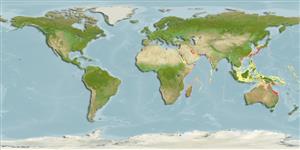>
Gobiiformes (Gobies) >
Gobiidae (Gobies) > Gobiinae
Etymology: Gobiodon: Latin, gobius = gudgeon + Greek, odous = teeth (Ref. 45335); fuscoruber: Named for its uniformly reddish-brown life colouration; name from Latin words 'fuscus' for brown and 'rubrum' for red; typical colouration throughout its distribution despite its geographic colour variants..
Environment: milieu / climate zone / depth range / distribution range
Écologie
marin récifal. Tropical
Indo-West Pacific, Red Sea, Japan andn Australia (GBR).
Taille / Poids / Âge
Maturity: Lm ? range ? - ? cm
Max length : 3.7 cm SL mâle / non sexé; (Ref. 94082)
Description synthétique
Clés d'identification | Morphologie | Morphométrie
Épines dorsales (Total) : 7; Rayons mous dorsaux (Total) : 10; Épines anales: 1; Rayons mous anaux: 8; Vertèbres: 26. This species is distinguished by the following characters: D Vi+I,0; A I,8; both head and body naked; distinct groove between isthmus and interopercle; deep body (the depth at pelvic-fin origin 40.4-44.3 % SL) and strongly compressed; juveniles with rounded head, large adults with steep profile, slightly hump-headed; caudal peduncle relatively slender (depth 14.8-16.0% SL); colour of juveniles and adults dark reddish brown with greenish subcutaneous gleam on dorsal part of body; median fins plain (western Pacific Oceans) or with pale margin (Red Sea and Indian Ocean); iris plain light blue (Red Sea) or scattered with red-brown dots on the outer margin (Ref. 94082).
Facultative air-breathing in the genus (Ref. 126274); Occurs on reef flats, crests and upper reef slopes in less exposed areas; and prefers Acropora selago, but also occurs in a number of other, narrowly branched Acropora species such as A. acuminata and A. hyacinthus (Ref. 94082).
Life cycle and mating behavior
Maturities | Reproduction | Spawnings | Egg(s) | Fecundities | Larves
Herler, J., S.V. Bogorodsky and T. Suzuki, 2013. Four new species of coral gobies (Teleostei: Gobiidae: Gobiodon), with comments on their relationships within the genus. Zootaxa 3709(4):301-329. (Ref. 94082)
Statut dans la liste rouge de l'IUCN (Ref. 130435)
Menace pour l'homme
Harmless
Utilisations par l'homme
Outils
Articles particuliers
Télécharger en XML
Sources Internet
Estimates based on models
Preferred temperature (Ref.
123201): 21.8 - 27.7, mean 26.2 °C (based on 807 cells).
Phylogenetic diversity index (Ref.
82804): PD
50 = 0.5000 [Uniqueness, from 0.5 = low to 2.0 = high].
Bayesian length-weight: a=0.01995 (0.00906 - 0.04395), b=3.01 (2.83 - 3.19), in cm total length, based on all LWR estimates for this body shape (Ref.
93245).
Niveau trophique (Ref.
69278): 3.4 ±0.4 se; based on size and trophs of closest relatives
Résilience (Ref.
120179): Haut, temps minimum de doublement de population inférieur à 15 mois (Preliminary K or Fecundity.).
Fishing Vulnerability (Ref.
59153): Low vulnerability (10 of 100).
